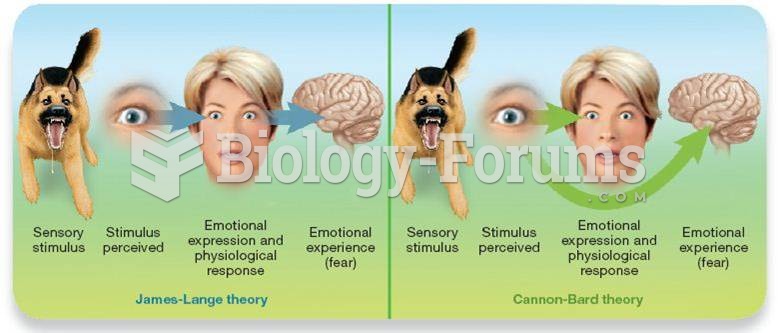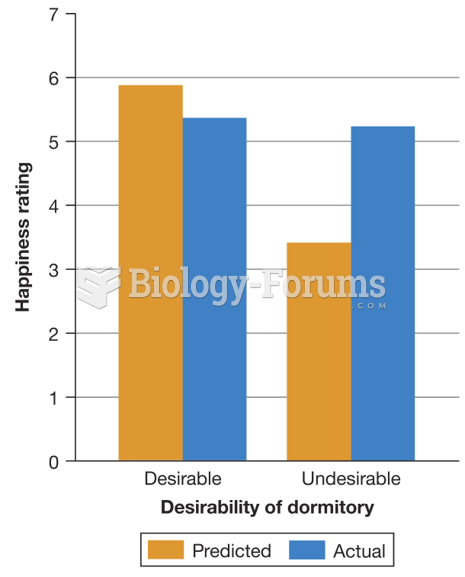Answer to Question 1
ANSWER:
The JamesLange theory of emotion proposes that physical sensations lead to subjective feelings. At the core of the JamesLange theory is the idea that classes of emotions are the result of a sequence of events. Once an individual perceives a stimulus, such as a grizzly bear, he or she will experience a physiological response. This physiological response is subsequently interpreted by the individual, giving rise to a conscious awareness of a subjective feeling.
The CannonBard theory of emotion features the simultaneous and independent occurrence of physical sensations and subjective feelings during an emotional experience. For CannonBard, the sight of the bear would immediately and simultaneously trigger a subjective feeling of fear (oh no, theres a bear in my room) and physical sensations (probably the autonomic nervous systems fightflight response in this example). The CannonBard theory does not assume that the experience of a subjective feeling is dependent on any physical sensations.
The SchachterSinger two-factor theory asserts that general arousal leads to assessment, which in turn leads to subjective feelings. Schachter and Singer believed that each emotional experience begins with an assessment of our physical sensations. Because these reactions can be similar among emotional states (i.e., fear and sexual arousal), they suggested that interpreting these states requires another step. Any emotional arousal signals us to make a conscious, cognitive appraisal of our circumstances, which then allows us to identify the emotion were experiencing. Physical sensations may lead to several different interpretations, based on the way an individual assesses a situation. The sight of a bear would initiate a general state of arousal. To identify the source of your arousal, you would assess your situation, attribute your arousal to the presence of a bear in your room, and identify your feelings as fear.
The Somatovisceral Afference Model of Emotion (SAME) begins with a recognition that physical responses to a stimulus can range from quite specific to quite general. For example, the physical sensations associated with disgust can be more precise than the physical sensations associated with pride. The initial degree of specificity of the physical response leads to different cognitive processing. A highly specific physical response leads to unambiguous recognition of a subjective feeling. (e.g., A bear walks in, I react physically, I know Im scared). At the other extreme, instead of specific physical responses, a situation might produce very general arousal, which will require significant cognitive processing and evaluation. For example, a valedictorian giving a graduation speech might not understand her arousal until she sees her parents and other members of the audience clapping and realizes the emotion she is feeling is pride.
Answer to Question 2
ANSWER:
Maslow viewed motivation as a hierarchy of needs, in which lower levels must be satisfied before the individual has the time and energy to pursue higher level needs. At the lowest level of the pyramid, we find physiological needs, including food, water, and shelter. These basic needs must be met on a daily basis, or life will be threatened. Consequently, if meeting these needs is a challenge for a person, Maslow predicted that the person is unlikely to care about needs appearing at higher levels of the hierarchy. Once physiological needs are generally met, Maslow suggests that we turn our attention to safety, and then to belongingness, represented by the love and affection of others. For Maslow, these three lower categories are essential to human life. Freed from the challenges of meeting basic needs, we begin to seek esteem, or the respect we receive from other members of the community. At the pinnacle of human striving, however, is the goal of self-actualization, according to Maslow. A person seeking self-actualization desires to fully meet his or her potential.
Maslows classic theory received a recent modification that retained the overall hierarchical organization but added three new perspectives: the evolutionary functions of motives, the development of motives over the life span, and the cognitive priorities assigned to motives in response to environmental stimuli. This modified pyramid replaces self-actualization with mate acquisition, mate retention, and parenting. The authors of the revision noted that self-actualization was interesting, but they could not find an evolutionary explanation for why we would seek to reach this level. Many of the activities described by Maslow as helping people to reach self-actualization, such as art and poetry, might be better explained as efforts to gain status, which in turn would attract mates.







